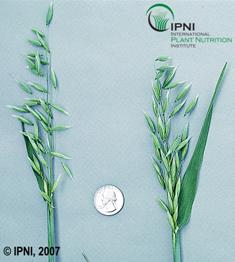Oat
Adaptation
- South and central GA.
- Oat can be winterkilled in some years.
- Soil pH should be kept above 6.0 for best results.
Establishment
Seed in late August-October. See Establishment of Cool Season Annual Grasses for more details.
Recommended Varieties†
Horizon 214 (L), Horizon 306, Horizon 578 (L), Horizon 720 (E), and Trical Cadillac*.
Legend 567 and LA99016 has performed well in the past, but not been recently evaluated.
All oat varieties listed above are susceptible to crown rust, avoid early plantings.
Legend 567 and LA99016 have performed well in the past, but not been recently evaluated. No varieties have been recently tested in Limestone Valley.
† Recommended varieties have consistently demonstrated above average yields in UGA variety trials. Other varieties may provide satisfactory yields but were either not consistently above average or were not submitted to the Statewide Variety Trial program.
E = Performed better in early season yield evaluations compared to later in the season for the recommended varieties.
L = Performed better in late season yield evaluations compared to later in the season for the recommended varieties.
In-Depth
 Oat is a small grain often used for winter forage production in Georgia. When seeded in mid-fall, they furnish forage in late fall and spring. Oat is not as cold hardy as rye and can winter-kill during harsh winters. This crop produces more forage in spring than rye and can be cut for hay or silage. However, it is not as productive as ryegrass in the spring and is not very grazing tolerant. Planting oat in a mixture with ryegrass and/or a winter annual legume will produce more total forage over a longer grazing season than oat alone.
Oat is a small grain often used for winter forage production in Georgia. When seeded in mid-fall, they furnish forage in late fall and spring. Oat is not as cold hardy as rye and can winter-kill during harsh winters. This crop produces more forage in spring than rye and can be cut for hay or silage. However, it is not as productive as ryegrass in the spring and is not very grazing tolerant. Planting oat in a mixture with ryegrass and/or a winter annual legume will produce more total forage over a longer grazing season than oat alone.
Establishment of Oat
Establish oat on well-drained, fertile soils when possible. If the sites are somewhat poorly-drained, ryegrass will be a better choice than oat or the other small grains. Treat small grain seed with an approved fungicide prior to planting. Seedling diseases such as Phytophthora, Rhizoctonia, Pythium, and others reduce stands when planted in the warmer months of September and October, especially in south Georgia.
Oat can be seeded between late August and early October in the Limestone Valley/Mountains region, early September and mid- to late October in the Piedmont region, and late September to late October in the Coastal Plain region. If late fall and early winter grazing is desired (lower Piedmont and Coastal Plain regions only), plant at the earlier dates of these ranges and into a prepared seedbed. Do not overgraze these pastures during the late fall or early winter. For best results, maintain at least 2 ½ in. of stubble height.
If planting into a prepared seedbed, prepare the seedbed two to three weeks before planting, if practical. This will allow the soil to settle and firm, thus improving seed germination and seedling development. Although deep soil preparation is not necessary for the grazing crop, deep tillage may benefit row crops planted in the spring.
Seed can be placed more precisely with a drill or cultipacker seeder than by broadcasting and disking. When seed are broadcast, increase the seeding rate by 25 – 30% to allow for variable seed placement. Plant small grain seed 1 – 1 ½ in. deep in moist soil. If ryegrass is used in mixtures with oat, do not plant ryegrass seed deeper than ½ in. When planting mixtures of ryegrass and oat, it may be easier to control the seeding depth of these species by broadcasting ryegrass seed and then drilling the small grain seed into the seedbed.
Apply 40 – 50 lbs of N per acre at planting or soon after the plants emerge to increase growth, tillering (thickening of the stand), and provide earlier grazing. A second application of 40 – 50 lbs of N per acre should be applied in mid-winter to increase winter and spring forage production. Because ryegrass is longer-lived, a third application of 40 – 50 lbs of N per acre may be needed in early spring when ryegrass is used for late spring grazing, hay, or silage crop. Rates of N in excess of these amounts may result in substantial N losses to leaching and excessive growth during the winter. Fresh, tender growth that occurs when nitrogen is in excess could be damaged by extremely cold weather.
Dr. Dennis Hancock
Forage Extension Specialist
Crop & Soil Sciences Dept.
